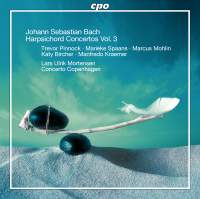Texte paru dans: / Appeared in: |
|
|
Outil de traduction ~ (Très approximatif) |
|
|
Reviewer: Alex
McGehee Perhaps the most disheartening fact facing anyone engaged in the study, performance, or love of Bach’s music is to consider the body of work we have as opposed to what is lost. Innumerable instrumental works are gone, as are many sacred and secular cantatas. The custodians of these priceless treasures were Bach’s eldest sons. The senior of the Bach children, Wilhelm Friedemann Bach (1710–1784), was forced to sell off many of his father’s works. He died in abject poverty despite a brilliant earlier career. As for the musical inheritance from his father, we have no trace. Six of the seven concertos recorded in this release have their roots in earlier Bach works, now mostly lost. The sole exception is the Concerto for Four Harpsichords, which Bach arranged from Vivaldi’s L’Estro armonico, op. 3/10. The importance of drawing attention to this reworking of earlier, lost works is that in almost every case where we can compare an extant earlier work with a newer version, the changes Bach makes are so profound that the newer work stands on its own as an independent creation. This recording reunites two musicians who recorded almost all of the same repertoire for the DG Archiv label more than 25 years ago. In the Archiv release, Trevor Pinnock led the English Concert (the ensemble he founded) from the harpsichord, and Lars Ulrik Mortensen (at one time Pinnock’s student), played one of the other instruments. This time their roles are reversed and it is Mortensen who is leading the Concerto Copenhagen from the harpsichord, with Pinnock at his flank. Marieke Spanns and Marcus Mohlin provide additional support in the concertos for three and four harpsichords. The keyboard instruments employed in this new recording—all of them modern reproductions of 17th- and 18th-century harpsichords—are its best feature, along with the musicians who play them. When they are in the spotlight, frequently in the slow movements, this recording shines. When they are not—as is too often the case—there is a struggle to find a union between soloists and ensemble, causing the musical lines to suffer. At times, the ensemble sounds disconnected from the soloists with whom they are playing. In other passages a muddy, unfocused bass lumbers through the music where its intent should be to provide a solid harmonic foundation. It is chiefly from these shortcomings that Mortensen and the Concerto Copenhagen fall short. The DG Archiv recordings—including another Archiv release from 1984 featuring the Triple Concerto and a reconstruction of the lost Concerto for Oboe, Violin, and Strings—are still in the running, proving that the teacher still has something to show the student. Quite an accomplishment for Trevor Pinnock and the English Concert. | |
|
|
|
|
Cliquez l'un ou l'autre
bouton pour découvrir bien d'autres critiques de CD |
|




